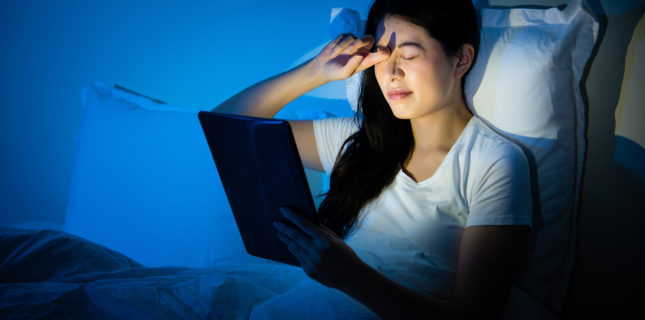
Blue light…communicating with consumers
Consumers get mixed messages about blue light. And, it’s difficult for them to comprehend how some blue light is, well, good, while too much, however, is bad. To help staff better communicate with patients about this all-important, albeit confusing, topic, here we share some consumer-friendly factoids about blue light…the good, the bad, and the ugly, as they say. Since not all consumers want the same level of information, here we include both a “BASIC” and a “MORE INFO” version of blue-light education.
Tip: “Switch overhead lights to full spectrum ones and use smart home-tech solutions to dim lights gradually or at a set time.”
ZZZZ.
• BASIC… Exposure to blue light regulates circadian rhythm—that is, your wake and sleep pattern. Too much exposure to computer or device screens before bed can disturb that natural rhythm and keep you awake. On the other hand, too little daytime exposure to the blue light outdoors may, for example, adversely affect your child’s visual development.
• MORE INFO… As explained by the National Center for Biotechnology Information, blue wavelengths suppress sleep-inducing delta brainwaves and boost alertness-creating alpha wavelengths.
LIGHTS ON/OFF
• BASIC… Andrew Simon, N.D., from Bastyr Center for Natural Health, suggests you switch overhead lights to full spectrum ones and use smart home-tech solutions to dim lights gradually or at a set time.
• MORE INFO… According to the Endocrine Society, in comparison to dim light, nighttime exposure to room light suppresses melatonin by around 85 percent. Harvard University neuroscientist Anne-Marie Chang explains, “Light in the early evening causes a circadian delay or resets the clock to a later schedule. Light in the early morning causes a circadian advancement—that is, resets the clock to an earlier schedule.”
DING DONG
• BASIC… For many consumers, blue light still doesn’t ring a bell. And they don’t make the connection between using devices and discomfort. According to an American Eye-Q survey, “40% of Americans surveyed don’t think digital devices harm vision.”
• MORE INFO…In research conducted by The Vision Council, more than half (52.2%) of respondents say they use two digital devices at once. The result is an increase in reported symptoms:
31%…eye strain
22%…dry eyes
22.6%…headache
22.1%…blurred vision
30.1%…neck and shoulder pain
HELP, PLEASE
• BASIC…A picture is worth a thousand words. That means videos are worth even more. They can definitely be a big help in educating patients about blue light.
• MORE INFO… Hone in on Shamir Blue Zero with help from this video: https://www.shamirlens.com/products/materials-products?tab=120
How do you discuss blue light with your patients? Tell us and share in the conversation on Facebook here.
Comments are closed.







